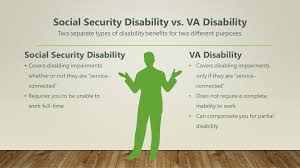What is the Difference between SSDI and VA Disability? SSDI and VA disability benefits are both government programs that help disabled individuals receive benefits. Both programs have separate application processes. They also have different requirements for determining disability.
SSDI vs. VA Disability: general requirements
VA disability benefits provide payments only to US veterans. The VA does not require any financial contributions. Additionally, the VA doesn’t require you to have worked within the last 5 or 10 years. Unlike VA disability, you don’t need to be a veteran to apply for SSDI. SSDI does require that you meet certain medical and non-medical requirements.
SSDI does require that you worked and earned enough work credits. Generally, you need a total of 20 work credits to qualify for SSDI. Typically, you need to have worked 5 out of the last 10 years. However, if you are younger, you may qualify for SSDI with fewer credits.
SSDI disability defined
SSDI requires that you have a medical condition that prevents you from working. Your condition must keep you from working for at least 12 months. Unlike VA disability benefits, SSDI does not need your disability to be connected to military service. They also don’t consider your discharge status.
VA disability defined
VA disability benefits, also known as service-connected disability, have specific requirements. You must show that your disabling condition was “incurred or aggravated by your military service.” You must not have a dishonorable discharge. You must also submit a formal claim by completing an “Application for Disability Compensation and Related Compensation Benefits” or VA Form 21-526EZ. Starting to understand the difference between SSDI and VA disability?
SSDI vs. VA Disability: percentage of disability
SSDI doesn’t distinguish between partial or total disability. Therefore, you must show that your medical conditions keep you from working in any job. Social Security figures out your monthly payment based on what you paid into Social Security. Even so, VA disability benefits don’t require total disability. The VA awards benefits based in proportion to their percentage of disability. Compensation rates range from 10%-100%, in 10% increments. Therefore, SSDI does not have percentages and VA disability does.
SSDI application process
Firstly, Social Security considers whether your medical conditions fall under their listing of impairments, known as the Blue Book. Secondly, the Blue Book requires that your medical conditions meet very specific requirements. Thirdly, if you don’t meet the listings, Social Security considers your residual functional capacity or RFC. An RFC includes both physical and mental limitations.
Social Security looks at your medical evidence to determine your RFC. They can also consider the opinions of your doctors. Social Security may also ask you to attend an appointment with one of their doctors. Social Security will schedule an exam when they need more information about your conditions.
VA disability application process
Veterans go through a VA-directed medical review. The VA uses military doctors and other health personnel to evaluate veterans for their disability. Similar to SSDI, the VA may ask you to attend a VA claim exam, known as a C&P exam. The exam will help the VA rate your disability. The VA assigns a disable rating to each of your conditions. This determines your Total Combined VA Disability Rating. The Total Combined VA Disability Rating determines the amount of your benefits.
SSDI: your age matters
Social Security has special disability rules the older you are. They look at a chart known as the Medical-Vocational guidelines to evaluate your claim called the “grid rules.” The grid rules make it easier for older people to win their case. Social Security considers your age, education and work background. The older you are, the easier it can be to win your case. While SSDI considers your age, VA disability does not consider your age.
Example 1: applying the grid rules for SSDI
For example, James, a 56 year old veteran, applied for disability due to knee, shoulder and neck pain. He previously worked as truck driver, receives disability compensation related to a knee injury. He has trouble standing and walking, needs a cane. His medical records include MRIs and x-rays of his knees, shoulder and neck documenting his impairments. His doctors have also documented that he has pain and limited motion of his knees and shoulder. Social Security found that he could not return to work as a truck driver. Since he is over the age of 55, the grid rules allow Social Security to approve his claim.
SSDI and VA disability application wait time
Unfortunately, both VA disability and SSDI can take time to process before issuing a decision. VA disability applications can take anywhere from a few months to 2-3 years for a decision. SSDI has several levels of the claims process. Firstly, it may take 4-6 months to receive an initial decision. Secondly, if Social Security denies your claim, you file an appeal for reconsideration, Reconsideration can take 3-5 months. Thirdly, you can file a request for hearing, where it can take several months for your case to be scheduled. Social Security also has additional appeals if your case is denied at hearing.
SSDI expedited processing for Veterans
Veterans may qualify for faster processing for SSDI claims. You may receive expedited processing if you have a 100% Permanent and Total disability rating. Additionally, Social Security fast-tracks claims for Wounded Warriors. It include veterans who received disabling mental or physical health injuries while on active duty after October 1, 2001.
SSDI vs. VA disability: medical insurance
SSDI recipients receive Medicare. Medicare benefits start two years after Social Security finds you disabled. Medicare covers a variety of medical costs, usually regardless of condition. Though, it does not always cover all primary medical care. You may need an additional policy to supplement your benefits.
Veterans receiving VA disability are automatically covered by TRICARE benefits. TRICARE covers health costs deemed “medically necessary” for your condition. If you receive both SSDI and VA disability, Medicare becomes your primary insurance and TRICARE becomes your secondary insurance.
Call Now for a Free Case Review, 800-700-0652
Make sure you start your SSDI and VA disability claim the right way and apply for all the benefits you deserve. Contact us now for a free consultation.
Related Articles
- Is Osteoporosis a Disability?
- What is the Difference Between SSI and SSDI?
- I Just Received a Function Report Questionnaire from Social Security. What Should I Do?
- Why Your SSD Claim Might Be Denied?
- What is the SSDI Payment Schedule?
- How can I Check on My Disability Claim?
- Why Should I Hire a Disability Lawyer?
- What are the Over 55 Grid Rules?
- VA Benefits Appeal
- VA Disability Remand
- What are Social Security Disability Questions?







